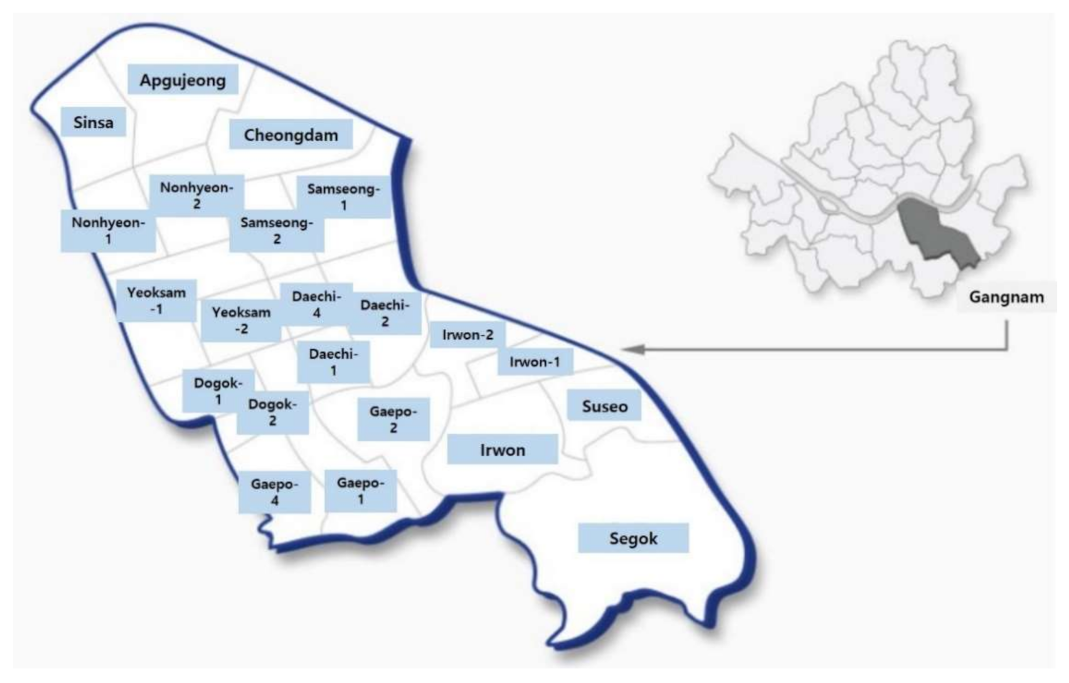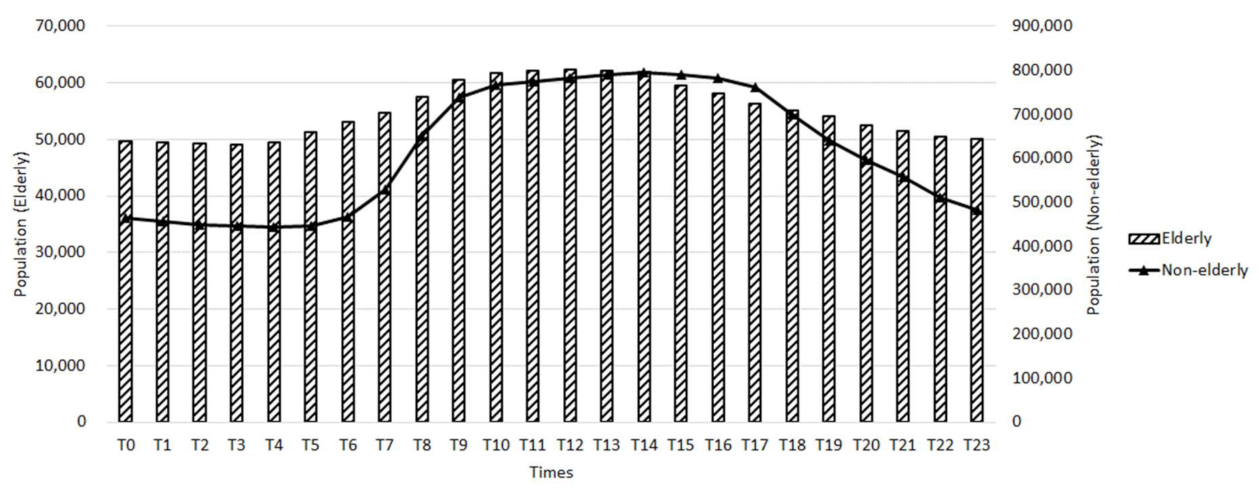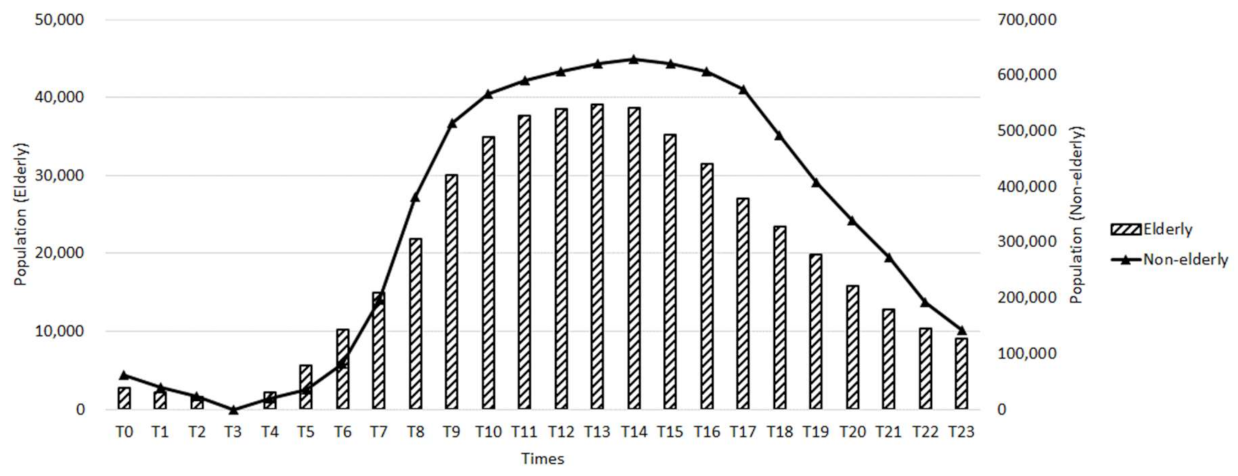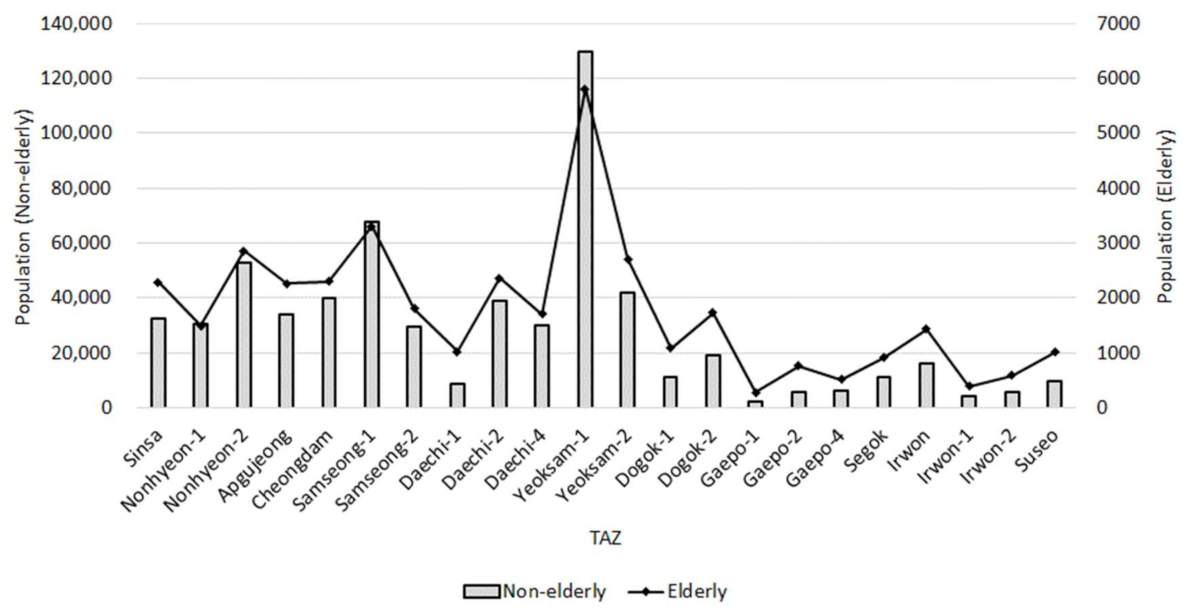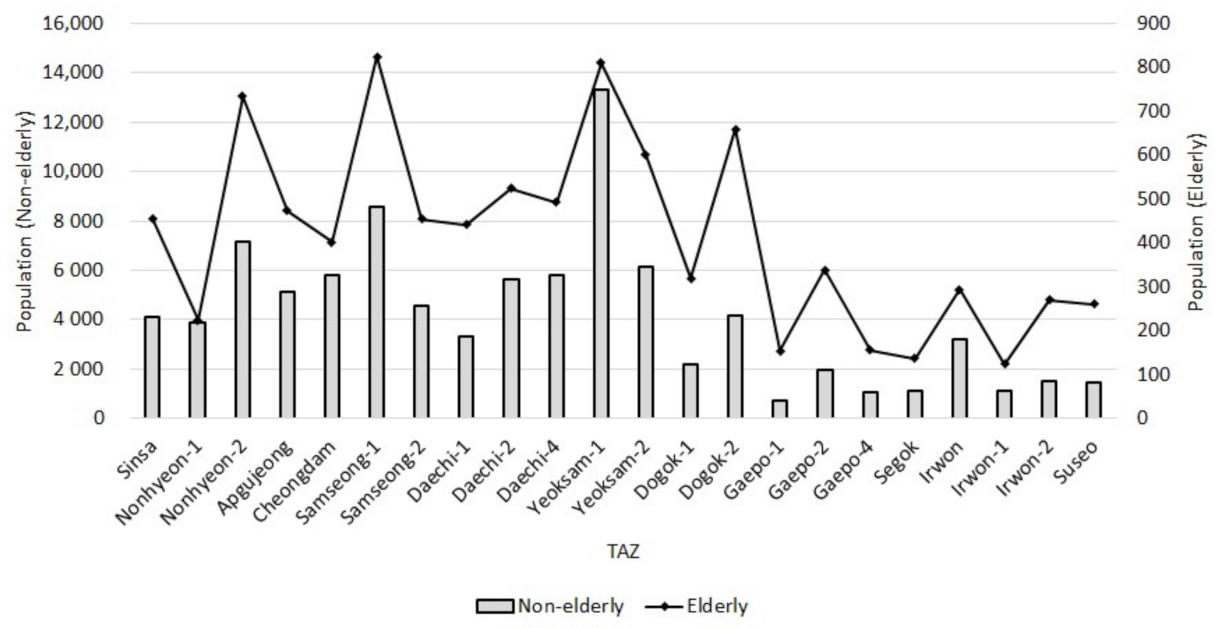1. Introduction
Rapid demographic ageing is a global challenge faced by all countries in the world. Population ageing is a long-term development that exists because of declining fertility, increasing longevity, and reduced family size [
1,
2]. The growing number and proportion of older people have various implications for society in relation to the economy, housing and living conditions, transportation systems, safety and health care, retirement systems, poverty and social exclusion, and social life [
3].
Although there is no clear definition of the term “elderly,” elderly people are normally defined as those aged 65 and over [
1,
3]. The worldwide population of elderly people was 703 million in 2019 [
1]. This number is projected to double to 1.5 million by 2050. Further, the percentage of elderly people increased from 6% in 1990 to 9% in 2019 and is projected to escalate to 16% by 2050. Like in many other countries, the population in Korea is ageing at a considerable rate. As of 2019, there were about 7.68 million elderly people in Korea, accounting for about 15% of the population [
4]. However, the proportion of the elderly is projected to increase to 20.3% by 2025 and 43.9% by 2060. Statistics Korea [
4] reports an ageing index defined as the number of the elderly per 100 people younger than 15 years old. This index was 100.1 in 2016 but increased to 119.4 in 2019 in Korea.
Because of the unprecedented rapid growth of the elderly population, understanding and addressing issues associated with all aspects of the elderly have become high priorities for policymakers. The lifestyles, activity, and travel behaviors of the elderly are different from those of the nonelderly. Clearly, the increase in the elderly population has significant implications for transportation planning. Considering that Korea is a high-density country, the rapid growth of the older population is expected to affect the transportation system significantly. It is essential for transportation planners and urban policymakers to understand the activity and transportation issues that affect the elderly as well as their socioeconomic characteristics.
In this regard, numerous studies with varying degrees of depth and sophistication have been conducted by focusing on the travel patterns and behaviors of the elderly. Existing research has been focused on diverse issues, including the travel characteristics and mobility of the elderly [
2,
5,
6,
7,
8], mode choice [
9,
10,
11,
12,
13,
14,
15], travel behavior changes over time [
16,
17], trip chaining [
18,
19], influence of the built environment [
12,
20,
21,
22,
23,
24,
25], and quality of life related to feelings of loneliness [
25].
A literature review of these studies suggests that the travel of elderly people is characterized by relatively fewer trips, short distances, and travel times than that of the nonelderly [
2,
6,
10,
11,
24]. The activity patterns of the elderly are also different from those of the nonelderly: the elderly tend to participate in fewer activities [
6,
24], spend more time at home, and conduct activities such as visiting, shopping, recreation, and leisure [
2,
6]. In addition, a distinction should be made between younger elderly and older elderly people because their travel patterns are not homogenous [
2,
10,
26,
27,
28].
Although many studies on diverse issues have been conducted to analyze the travel behaviors of the elderly, some shortcomings remain. First, most previous studies on the travel behaviors of elderly people have been exclusively based on data from developed or Western countries, probably due to data limitation in other countries. Very few studies have been conducted outside Western developed countries [
7,
10]. However, unlike in Western developed countries, land use is mixed, and the public transportation system is well developed in Korea. Therefore, activity and travel patterns are expected to be different from those in other countries. Second, previous research on the travel behaviors of the elderly has mainly been concentrated on the aggregated patterns of elderly people instead of individual movements and activities. Therefore, these studies have provided limited analysis of the spatiotemporal activity and travel characteristics of the elderly. Third, and most importantly, surveys constitute the most common method of collecting information on travel patterns, and most previous studies have relied on data sampled in this manner, such as household travel survey data. Household travel surveys constitute one of the principal data sources for transportation planning because they provide systematic records of trip information along with the household and personal characteristics. However, surveys require significant time and cost for collection and analysis. Further, such data sets represent only a small portion of the population (normally less than 5%), which may not be sufficiently large to clarify the spatiotemporal activity and travel characteristics of all people concerned. In addition, there are concerns regarding the sampled data quality and credibility; that is, some participants fail to recall their trips or record their trips faithfully [
29,
30,
31,
32,
33].
Because many existing studies have been heavily based on household travel surveys, it has been difficult to capture various factors regarding the mobility of people who have not participated in such surveys. However, new data types, such as mobile phone data, Global Positioning System (GPS) data, and smart card data, have recently become available due to technological developments in data collection. There is a growing interest in studying travel behaviors using these new data sources in transportation research. Several studies have highlighted the potential and significance of new data sources [
31,
34,
35,
36,
37,
38,
39,
40], because they can include various sociodemographic and travel characteristics of all people without exception. Although most GPS-based studies have still been based on a sampled data, mobile phone data that represent the total population have been analyzed in a few recent studies [
41,
42]. Analysis using data representative of the total population is crucial for fully understanding the activity and mobility behaviors of people and is especially interesting when studying a population that may experience different activity and trip patterns between age groups.
The mobility of the elderly is an essential element for active ageing [
43]. Given the impact of the ageing on our society and the importance of future sustainable transportation services for the elderly, it is urgent to understand the travel characteristics of the elderly. However, previous studies had some limitations on the analysis in terms of spatiotemporal activity and travel behaviors of the elderly due to using aggregated and sampled travel data. Therefore, the objectives of this study are (1) to present a detailed picture of spatiotemporal activity and travel patterns of elderly people using mobile-phone-based hourly locational trajectory data, which contain trip chains of individual and represent the total population as a whole, (2) to compare activity and travel patterns of the elderly with other age and gender groups, and (3) to draw implications for future sustainable transportation for the elderly. For this purpose, we present a case study of Gangnam, Korea, which has a well-developed public transportation system and mixed land uses. It is expected that this study will help to provide useful information and insights for the development of sustainable transportation systems for the elderly in the future.
The remainder of this paper is structured as follows.
Section 2 presents a literature review relevant to this study.
Section 3 describes the hourly location data obtained from mobile phones.
Section 4 presents the hourly present-in-area population categorized by age, gender, and location of residence; the activity participation by time, type, and location; the activity duration by type; and the trip frequencies and start times. Finally,
Section 5 provides a discussion on insights for transportation policy, including sustainable transportation for the elderly, and concludes the paper with the summary of findings, limitations of the present study, and topics for future work.
2. Literature Review
Numerous researchers have analyzed the travel behaviors and activity participation of the elderly from different perspectives. Fatima et al. [
5] presented systematic literature reviews on the accessibility and mobility of elderly people, including travel patterns, mode preferences, infrastructure solutions, accessibility indices, mode choice models and datasets. Corresponding studies have been conducted on the factor influencing the travel behaviors of the elderly, including gender, employment status, driver’s license ownership, educational level, and household income. For instance, women and the unemployed elderly have low frequencies of travel and short travel distances, and women more rely on public transport [
8]; the possession of a driver’s license is associated with frequent travel [
12]; and a higher level of education is associated with more frequent travel and the use of public transportation among the elderly [
11]. In general, it is understood that older people take fewer trips, shorter trips in terms of travel time and distance, and more non-car-driving trips as driving ability decreases with age [
2,
6,
10,
11,
24,
44,
45]. Schmocker et al. [
28] estimated the trip generation of elderly and disabled people using London-area travel survey data. The authors concluded that increasing age results in both fewer trips and shorter distances traveled. Household structure, car ownership, and possession of a driver’s license were also found to affect trip rate and distance. Income was highly related to frequency of recreational trips and total distance traveled.
Although most previous studies have indicated that there are differences in travel behavior between the elderly and others, some studies have suggested different or mixed results. Johansson-Stenman [
46] found that both the probability of driving and expected annual driving distance reach their peaks at about the age of 50. On the other hand, van den Berg et al. [
47] found no significant age effects on travel distance or time between young adults and the elderly in the Netherlands. He et al. [
48] also found no significant difference on mobility between older and younger people in Hong Kong. Buehler and Nobis [
17] presented an interesting study comparing the travel behaviors of the elderly between Germany and the U.S. In both countries, elderly people were found to be more mobile today than in the past, but the elderly in the U.S. tend to make more trips by car than those in Germany. The Federal Highway Administration [
16] summarized the trends in household and personal travel patterns in the U.S. based on household travel survey data. According to the report, the average numbers of daily trips per person taken by all people younger than 65 in 2017 were significantly lower than those in 1995, 2001, and 2009. However, the average number of trips per person taken by the elderly in 2017 was not decreased much compared to those in previous years. On the other hand, mixed results were obtained for the travel patterns of the elderly: the number of vehicle trips per driver in 2017 was lower than that in 2009, whereas the number of trips and miles of travel per person both increased for the elderly.
Some researchers have analyzed transportation mode choices of elderly people. Both neighborhood and trip characteristics and personal and household characteristics are associated with the mode choices [
12,
13,
14,
15,
44,
49,
50,
51,
52,
53]. Wong et al. [
43] analyzed factors influencing on travel decisions of the elderly in Hong Kong, and the key factors were public transport modes, travel fare, walking and wait times, seat availability, and numerous socioeconomic factors. Jian et al. [
45] found that younger people in Beijing have higher propensities to drive a private car after they are over 65 years old, while improving public transport service can increase ridership of public transport for the elderly in the future. Zhang et al. [
54] analyzed travel patterns of elderly people during the morning peak hours. They found that bus is the most important transportation mode for the elderly, but the free bus program has induced only 4.85% of elderly’s bus travel. Liu et al. [
9] examined travel characteristics and access mode choice of elderly urban rail riders in Denver, Colorado, and found that the built environment and vehicle ownership were important variables for the mode choice of elderly people.
In addition, several studies have investigated the travel patterns of the elderly and compared them with those of other age groups and among subgroups of the elderly population [
2,
10,
51,
52]. Shao et al. [
55] examined elderly people’s travel patterns between weekday and weekend, and compared them with younger people. Jordan et al. [
26] investigated travel time and duration of the two elderly groups and showed their disparities. Shi et al. [
56] investigated bus travel characteristics of the elderly using smart card data and compared them with nonelderly people. Boschmann and Brady [
6] found that total number of trips and mean distance decline with age, but each age group among the elderly exhibits unique behaviors. Kuppam and Pendyala [
57] found that the elderly aged 60 or older tend to engage in fewer nonhome activities than people in other age groups [
13]. According to Liu et al. [
10], middle-aged and younger people with high household incomes had few trips, whereas the opposite was the case for older people. In the elderly group, women had fewer trips than men, but there was no difference in the number of trips between genders in the middle-aged and younger groups.
Although many studies have been conducted on the travel behaviors of the elderly as reviewed above, most of them have been focused on Western countries. The activity and travel behaviors of elderly people in the rest of the world is not well known, and there is limited corresponding research. The international case studies on the elderly’s travel behaviors are China [
10], Hong Kong [
2,
43,
48], Nigeria [
7].
By now, there is quite a substantial body of literature on the activity and travel behaviors of the elderly. However, most previous studies have relied heavily on household travel survey data. Household travel surveys are primarily used to understand travel behaviors because they provide daily trip information along with the household and personal characteristics of travelers. For instance, the household travel survey in Korea consists of two levels: (1) person and household characteristics, including age, gender, type of job, number of household members, housing type, driver’s license ownership, private vehicle availability, and household income; (2) a complete record of every trip of the day, including the departure and arrival times, origin and destination, transport mode used, and trip purpose. Even though household travel survey data are crucial for fully understanding mobility patterns, several researchers have noted the limitations of survey data [
29,
30,
31,
39,
40]. First, a survey represents a small subset of the population of interest (normally less than 5%). Second, data collection requires significant time and cost. Third, survey data acquisition requires the active involvement of the respondents as they must record the details of their trips. In addition, there is an issue regarding the accuracy and credibility of the data, because the respondents must rely on their memory and often fail to record their trips faithfully [
29,
30,
31,
32,
33]. Some researchers have compared data from travel diaries and corresponding GPS monitoring. Houston et al. [
58] summarized the corresponding studies, and the rates at which trips were not reported in travel surveys were identified in GPS data and varied substantially. The rates of unreported trips ranged from 7% in a survey in Sydney to 81% in the case of the survey in Laredo, Texas.
Recently, the rapid development and availability of inexpensive and reliable tracking devices has received increasing attention by transportation and urban planners [
31,
34,
35,
36,
37,
38,
39,
40]. The emerging data sources, including mobile phones, GPS, and transit smart cards, provide more accurate information, the opportunity for high temporal and spatial resolutions, and new insights for policymakers. What these three types of data have in common is that they are all trajectory data. Such data are now used in various ways in the transportation field. Advances in GPS technology have received substantial attention and can offer researchers the opportunity to understand travel patterns due to the advantages of low respondent burden, high resolution and precision of spatiotemporal information, and low cost of data collection. Dujardin et al. [
34] explored the potential opportunities of mobile phone data and applied the data to investigate climate change adaptation. Zhang et al. [
36] developed commute mode choice model by integrating actively and passively collected travel data, including in-vehicle GPS data and transit smart card data. There are many other studies using the advanced technology and data, such as GPS [
31,
39,
59,
60,
61,
62], mobile phone data [
30], and smart card data [
29,
63,
64].
In particular, with the increasing popularity of smartphones, mobile phone data constitute one of the most intensively used types of trajectory data in transportation studies. These data were originally corrected by cellular network providers for billing purposes. However, the data contain rich spatiotemporal information about human mobility patterns from a large user population. In addition to their spatiotemporal information, the most unique feature of mobile phone data is their prevalent scale and the overwhelming sampling penetration of the entire population, which has not been achieved using other types of data [
40]. For this reason, extensive research has been conducted using mobile phone data. Several studies have been focused on movement patterns [
42,
65,
66], travel behaviors [
67,
68], origin/destination (O/D) trips [
41,
69,
70], and identification of activity locations [
71] using mobile phone data.
5. Discussion and Conclusions
5.1. Discussion
Our approach differs from previous studies relying heavily on sampled household travel survey data, as we used mobile phone-based hourly locational trajectory data. The data have several advantages over existing household travel survey data. Since typical travel survey data represent only 2–3% of the total population, making it difficult to understand the activity and travel pattern characteristics of the entire population. In particular, the reliability of such data is limited; for instance, some trips may be omitted because travel surveys rely upon the memories of the respondents. On the other hand, because the mobile phone data represent the entire population and capture the location of each person each hour, it is possible to identify peculiarities and behaviors that cannot be found in travel survey data and to analyze activity and travel characteristics by age and gender.
Mobile phone data provides important clues for understanding the travel behaviors of all age groups, including individual activity (i.e., time, place, and duration) and travel patterns (i.e., location and time of trip, trip chains). The only missing information from the data is the identification of transportation mode used by travelers. Most of the elderly are retiree and in-vehicle travel time may not be a key factor of transport mode choice for the elderly. As previous studies indicated, other factors seem to be more important, including perceived health condition, income, region of residence, gender, travel fare, travel distance, wait times, and built environment [
9,
10,
43,
49]. However, existing researches contain conflicting stories. Private car, public transportation, and walking are the main means of mobility for the elderly. While the use of transit and walking is crucial for sustainable transportation, the use of private vehicle is gradually increasing [
22,
44,
45,
75]. In addition, personal mobility (i.e., kickboard) and demand responsive transit were introduced as a means of first- and last-mile accessibility. Accordingly, it is necessary to examine whether these new mobilities are suitable for the elderly. Uses of public transport, walking, and shared riding are vital for sustainable society and transport in the future. Hoof et al. [
76] emphasized the importance of making cities age-friendly. They presented two examples of projects in the Netherlands and Poland. UN [
77] established 17 sustainable development goals and published the 2030 agenda for a sustainable future, including sustainable transport. It has been demonstrated in a number of literatures that, as individual vehicles decrease and use of active modes increase, it has a positive impact on the environment, such as greenhouse gas emission [
78,
79,
80,
81]. Therefore, urban and transportation planners should prepare how to create a sustainable and healthy society for the future transportation, especially for elderly people. In addition, accessible built environment, for instance access to bus stop or subway station, is another important issue for the elderly. In this study, we found that Yeoksam-1 is the area where elderly people are most active, so that adequate accessibility, convenience and safety for the use of public transport and walking environment in this area need to be evaluated.
The population of old people in Korea is growing extremely rapidly and is expected to grow at an even faster rate in the near future. Consequently, there is an increasing need to provide transportation services for nondriving older people in Korea. The elderly population was found to be more active because of higher income and health levels than in the past, and as a result, the amount of movement was large. In fact, many elderly people still drive, and traffic accidents are increasing as a result. Some countries have implemented policies to reinstate driver’s licenses for the elderly, but in Korea, the return rate is very low because mobility by private car is still convenient for the elderly. Therefore, it is necessary to expand transportation services at the level of passenger cars to resolve the active mobility needs of the elderly population and to implement a safe transportation policy. In particular, when autonomous vehicles are introduced for practical use, the main service target can be the elderly, and the expansion of demand-responsive public transportation is necessary. Further, the policy of introducing short-distance personal mobility modes that consider the activity locations and travel distances of the elderly is necessary. Knowing when and where older people are active is particularly important for providing transportation systems and facilities and developing efficient and effective transportation strategies.
5.2. Conclusions
The populations of most countries around the world are ageing. The rapid increases in the elderly population and the proportion of elderly people in society have tremendous implications for transportation planning, because the elderly represent a distinctive component of society. Transportation systems in the development era have been lacking in consideration of transportation welfare and services. In cities with a large number of elderly populations, the introduction of transportation systems and services for the elderly’s activities and mobility is becoming more important. Korea is also experiencing a significant demographic transition to a more aged society. The rapidly increasing number of older people necessitates new infrastructure and places for these individuals as well as easily accessible transportation systems. Hence, an understanding of the activity and travel characteristics of elderly people is crucial for transportation planning and the entire society to maintain mobility and accessible living environments.
The objective of this study was to explore the activity and travel patterns of the elderly and nonelderly. Analysis was performed with high temporal and spatial resolutions thanks to the use of locational trajectory-based mobile phone data, considering Gangnam, Korea as a case study. Based on hourly locational trajectory mobile phone data, we investigated the hourly present-in-area population and performed detailed analysis by age, gender, and residence of the average numbers of home and nonhome activities, amounts and locations of nonhome activity by hours per day, average numbers of trips reflecting trip chaining, average activity time and duration, and travel departure time.
The overall results of this study were consistent with common sense and the existing research. New findings that could not be analyzed using the existing household travel survey data were also presented. Above all, it was confirmed that the activity and travel patterns differed between nonelderly and elderly people and between men and women. Although hourly present-in-area population showed the similar patterns to both elderly and nonelderly people in Gangnam, nonelderly population increased rapidly during the daytime. We found that more than twice as many nonresidents visited from outside Gangnam, where there are many work and business offices. It implies that there are limited facilities or amenities for elderly people. In terms of activity behaviors by age group, the home activity time and duration were longer for the elderly than for the nonelderly. Elderly people also tend to participate in more nonhome activities per day than other people. Similar to previous studies, our analysis showed not only heterogeneous activity and travel patterns by age group but also slightly differences within the elderly group. Specifically, the average number of nonhome activities gradually increased from the people in their 20s to those aged 50–65 (4.17 times/person), then gradually decreased after age 65. In addition, men of all ages had more activities than women, which shows consistent results with previous studies (i.e., [
8]). We also found that average duration of nonhome activities of nonelderly men was shorter than that of nonelderly women, while average duration of nonhome activities of elderly men was longer than that of elderly women. Time periods for major nonhome activity were also different by age group. The nonelderly’s activities were mostly occurred from 8:00 a.m. to 7:00 p.m., while the elderly’s activities were occurred from 9:00 a.m. to 5:00 p.m., as it is consistent with the existing literatures (i.e., [
2,
5]). Elderly people do not engage in nonhome activities in the evening as much as nonelderly people. Most of the activities of the elderly are characterized by leisure and other activities (i.e., hospital visit, social gatherings, visiting to senior citizens’ centers, etc.). For this reason, short-distance and high-frequency trips occur due to various activities where the elderly involved, unlike ordinary adults who have fixed schedules at work and work-related activities. Elderly people also tend to delay departure times to avoid the traffic congestion peak in the morning and return home earlier than the nonelderly. It is worth considering transit services that meet these characteristics of the elderly and dissimilar travel patterns and destinations by different age group. For example, school buses operated by private businesses are mainly serviced in the early morning and late evening hours, so they can be operated as mobility services for the elderly during the daytime.
However, some results of this study differed from those of previous studies, and the following summarizes the observed trends that are unusual or different from those obtained in the existing research. Many previous studies have indicated that the numbers of trips taken and participation in activities by the elderly are reduced compared to those by the nonelderly [
2,
5,
6,
10,
11,
24], but this study interestingly showed that this situation is not necessarily the case. The average nonhome activity time per person for the elderly was shorter by about two hours than that for the nonelderly, but the average numbers of nonhome activities and trips were higher than those of the nonelderly. The reason for this difference is probably that elderly people are more likely to have driver’s licenses and take more trips, making them more mobile than ever before. In addition, the complete movement patterns of people can be analyzed in mobile phone data based on the hourly locational trajectory of each person, and peculiar traffic patterns such as those of delivery drivers could be found, which are difficult to obtain from typical household travel survey data because of the small number of samples. The characteristics of these data are expected to be useful for future travel demand forecasting and urban facility planning. In particular, it is necessary to understand properly the differences in travel behaviors through an in-depth comparison between the existing household travel survey data and the mobile phone data used in this study and to find a way to combine the advantages of the two types of data.
A number of limitations of this study suggest particular needs for further investigation. First, although the activity and travel needs of the elderly are increasing, their travel patterns and degrees of mobility are expected to differ by country and region as well as household and personal characteristics. Therefore, additional research is needed to see if there are differences in the activity and travel behaviors of the elderly according to region and local conditions. Another limitation is related to the data. Mobile phone data provide new, previously unfeasible, insights due to intensive sampling with high temporal and spatial resolutions. However, the data themselves do not provide comprehensive trip information and may not replace traditional household survey data. For instance, mobile phone data do not provide information on the specific activity type, trip purpose, mode of transportation, or exact home location, and it is very difficult to identify whether a traveler is moving or staying at a location. For a much deeper understanding of spatiotemporal mobility of elderly people, this emerging data source needs to be combined with other data sources.

